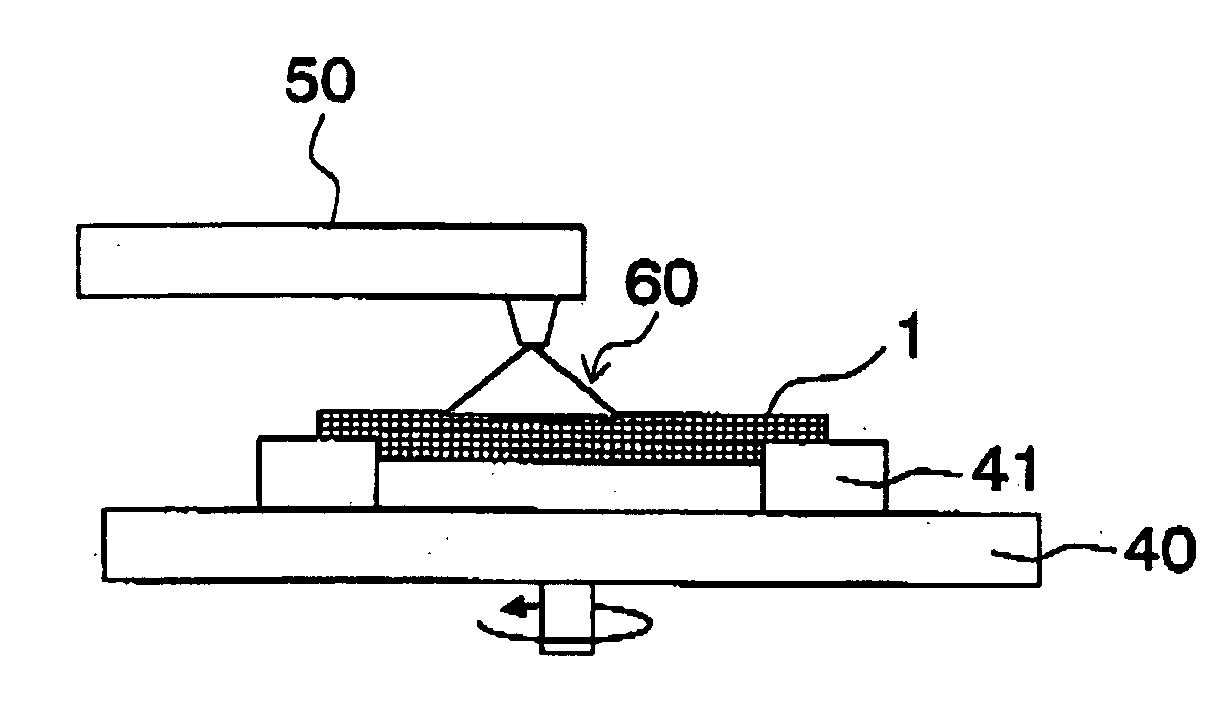Method for removing foreign matter from substrate surface
a technology for removing foreign matter and substrate surface, which is applied in the direction of photomechanical treatment, cleaning using liquids, instruments, etc., can solve the problems of difficult removal of foreign matter from the substrate, no electrical repulsive force, etc., and achieve the effect of suppressing surface roughness and preventing reattachment of once removed foreign matter to the substrate surfa
- Summary
- Abstract
- Description
- Claims
- Application Information
AI Technical Summary
Benefits of technology
Problems solved by technology
Method used
Image
Examples
example 3
[0161]The same treatment as in Example 1 is carried out except that the lamp application conditions in process 1 and the conditions of the spin method in process 2 are changed to the following conditions, and evaluations are carried out in the same manner as in Example 1. The results of the evaluations 1 and 2 are shown in the following Table.
(Process 1)
[0162]Dielectric barrier discharge lamp filled with Xe2 gas (dominant wavelength: 172 nm)
[0163]Luminance at the window wall 30: 10 mW / cm2
[0164]Gas (N2 / O2): 99.9 / 0.1 vol %
[0165]Exposure time; 30 min (application amount: 18 J / cm2)
[0166]Surface potential: −15 mV (at a pH of 3.1)
(Process 2)
[0167]Spin method (acidic solution): 0.1 wt % HP aqueous solution (room temperature, pH=2), 50 rpm×5 min
[0168]Rinsing: Deionized water (room temperature), 150 rpm×3 min
[0169]Spin drying: 1,200 rpm×1 min
example 4
[0170]The same treatment as in Example 1 is carried out except that the lamp application conditions in process 1 and the conditions of the spin method in process 2 are changed to the following conditions, and evaluations are carried out in the same manner as in Example 1. The results of the evaluations 1 and 2 are shown in the following Table.
(Process 1)
[0171]Dielectric barrier discharge lamp filled with Kr gas (dominant wavelength: 146 nm) Luminance at the window wall 30: 5 mW / cm2
[0172]Gas (N2 / O2): 99.9 / 0.1 vol %
[0173]Exposure time: 5 min (application amount: 1.5 J / cm2)
[0174]Surface potential: −30 mV (at a pH of 3.1)
(Process 2)
[0175]Spin method (acidic solution): 0.1 wt % HF aqueous solution (room temperature, pH=2), 50 rpm×5 min
[0176]Rinsing: Deionized water (room temperature), 150 rpm×3 min
[0177]Spin drying: 1,200 rpm×1 min
example 5
[0178]The same treatment as in Example 1 is carried out except that the lamp application conditions in process 1 and the conditions of the spin method in process 2 are changed to the following conditions, and evaluations are carried out in the same manner as in Example 1. The is results of the evaluations 1 and 2 are shown in the following Table.
(Process 1)
[0179]Dielectric barrier discharge lamp filled with Kr gas (dominant wavelength: 146 nm)
[0180]Luminance at the window wall 30: 5 mW / cm2
[0181]Gas (N2 / O2): 95 / 5 volt
[0182]Exposure time: 15 min (application amount: 4.5 J / cm2)
[0183]Surface potential: −50 mV (at a pH of 3.1)
(Process 2)
[0184]Spin method (acidic solution): 0.1 wt % HF aqueous solution (room temperature, pH=2), 50 rpm×5 min
[0185]Rinsing: Deionized water (room temperature), 150 rpm×3 min
[0186]Spin method (alkali solution): 1 wt % ammonia aqueous solution (room temperature)[0187]Ultrasonic waves at 1 MHz applied at the time of supply[0188]50 rpm×4 min
[0189]Rinsing: Deioniz...
PUM
| Property | Measurement | Unit |
|---|---|---|
| surface voltage | aaaaa | aaaaa |
| wavelength | aaaaa | aaaaa |
| wavelength | aaaaa | aaaaa |
Abstract
Description
Claims
Application Information
 Login to View More
Login to View More - R&D
- Intellectual Property
- Life Sciences
- Materials
- Tech Scout
- Unparalleled Data Quality
- Higher Quality Content
- 60% Fewer Hallucinations
Browse by: Latest US Patents, China's latest patents, Technical Efficacy Thesaurus, Application Domain, Technology Topic, Popular Technical Reports.
© 2025 PatSnap. All rights reserved.Legal|Privacy policy|Modern Slavery Act Transparency Statement|Sitemap|About US| Contact US: help@patsnap.com



